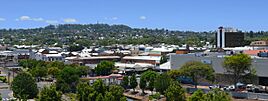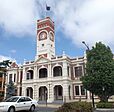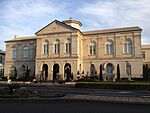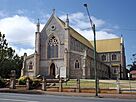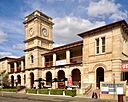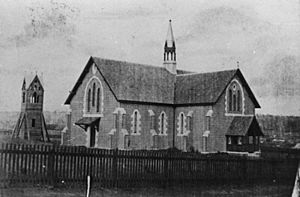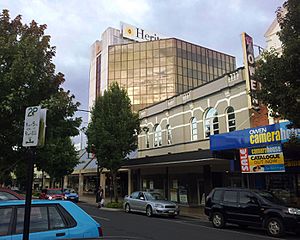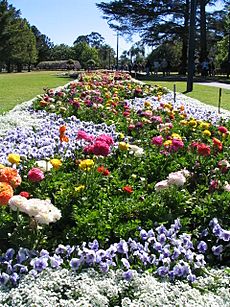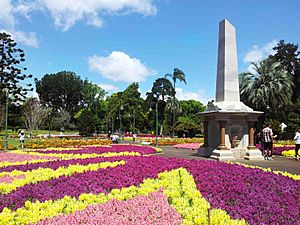Toowoomba facts for kids
Toowoomba (pronounced tə-WOOM-bə), often called 'The Garden City' or 'T-Bar', is a city in the Darling Downs area of Queensland, Australia. It's located about 132 kilometers west of Brisbane, Queensland's capital. In 2021, Toowoomba had a population of 142,163 people. It is the second-largest inland city in Australia, after Canberra, and is known as the capital of the Darling Downs. Toowoomba is also where the local government, the Toowoomba Region, is based.
Toowoomba is one of Australia's oldest inland cities, started in 1849 on the lands of the Giabal and Jarowair people. The city's main streets are named after the history of the House of Stuart. It used to be a summer getaway for Queensland's governors. The city saw important events during Australia's Victorian period, like the War of Southern Queensland and the Battle of One Tree Hill. During the time of Federation, Toowoomba became a big center for arts and culture with the start of the Austral Society.
Toowoomba is famous for its beautiful cathedrals and universities. It's loved for its old Victorian-era and traditional Queenslander style buildings, historic churches, lovely gardens, and a lively food and coffee culture. The city has cool street art, hidden laneways, and many nature trails. Toowoomba experiences all four seasons clearly and hosts festivals like the Carnival of Flowers. Important places to visit include Queens and Laurel Bank Park, the Empire Theatre, St James' Palace, and Mt Meewah. The surrounding Darling Downs area is known for its rolling hills, farms, and old homesteads.
Quick facts for kids ToowoombaQueensland |
|||||||||
|---|---|---|---|---|---|---|---|---|---|
|
|
|||||||||
| Population | 142,163 (2021 census) (16th) | ||||||||
| • Density | 195.118/km2 (505.35/sq mi) | ||||||||
| Established | 1849 | ||||||||
| Postcode(s) | 4350 | ||||||||
| Elevation | 691 m (2,267 ft) | ||||||||
| Area | 728.6 km2 (281.3 sq mi)(2021 urban) | ||||||||
| Time zone | AEST (UTC+10) | ||||||||
| Location | |||||||||
| LGA(s) | Toowoomba Region | ||||||||
| County | Aubigny | ||||||||
| State electorate(s) |
|
||||||||
| Federal Division(s) | Groom | ||||||||
|
|||||||||
Contents
- What's in a Name? The Origin of Toowoomba
- Toowoomba's Location and Natural Beauty
- Toowoomba's Story: A Look at its History
- Toowoomba's Weather
- Buildings and History: Toowoomba's Architecture
- How Toowoomba is Governed
- Toowoomba's Economy
- Learning in Toowoomba: Education
- Toowoomba's Culture
- Sports in Toowoomba
- Community Groups
- Media in Toowoomba
- Getting Around: Transport in Toowoomba
- City Services: Toowoomba's Infrastructure
- Famous People from Toowoomba
- Sister Cities
- Religion in Toowoomba
- See also
What's in a Name? The Origin of Toowoomba
The exact meaning of the name "Toowoomba" isn't fully known, but most people agree it comes from an Aboriginal language.
When Europeans first found the area, they called it "Drayton Swamp" or just "The Swamp." One idea is that local Aboriginal people started calling it "Tawampa," which sounded similar to "The Swamp."
Another idea comes from author Steele Rudd. He thought the name came from "Toogoom," because of the reeds that grew there. He also remembered an Aboriginal name for "The Swamp" was Chinkery Yackan, meaning "water like the stars."
The wife of an early settler, Thomas Alford, said Aboriginal people called the area "Woomba Woomba," meaning "the springs and the water underneath." She said they added "too-" to make it "Toowoomba."
In 1875, William Henry Groom wrote that "Toowoomba" meant "great in the future" in an Aboriginal language, but he didn't say where he got this information.
A botanist named Archibald Meston suggested that "Toowoom" or "Choowom" was the local Aboriginal name for a small native melon. He said "ba" meant "there," so the whole word meant "melons there," or "the place where the melon grows." Even though this melon still exists, there's no proof it grew near the Toowoomba swamps.
Toowoomba's Location and Natural Beauty
Toowoomba sits high up on the Great Dividing Range, about 700 meters above sea level. Most of the city is west of this mountain range.
The city is built on the edge of the range and the lower hills behind it. Two creeks, East Creek and West Creek, start from springs and join together north of the city center to form Gowrie Creek.
Gowrie Creek flows west into the Darling Downs and is part of the Murray–Darling basin. Water from Gowrie Creek travels about 3,000 kilometers to the Murray River near Adelaide. However, rain that falls on the eastern side of Toowoomba flows east towards Moreton Bay, which is about 170 kilometers away.
The rich volcanic soil in the area helps keep Toowoomba's 159 public parks green and beautiful. Many streets are lined with Jacaranda, camphor laurel, and plane trees. The city is known as 'The Garden City' because of its famous Carnival of Flowers festival every September. Many parks have Deciduous trees from around the world, which create a stunning display of autumn colors.
Toowoomba's Suburbs
The City of Toowoomba includes these suburbs:
|
Toowoomba's Story: A Look at its History
The First People of the Land
The Giabal and Jarowair people are known as the main Aboriginal language groups of the Toowoomba area. The Giabal lived south of the city, and the Jarowair lived north, reaching places like Crows Nest and Oakey.
The landscape changed a lot from 1840 when British settlers arrived. Many Aboriginal Australians faced difficult times and were forced to move to the edges of society or to missions. Some worked on farms around Toowoomba. Important ceremonies, like the Bonye Bonye festival, continued until the late 1800s. Groups from different parts of Queensland and New South Wales would gather at Gummingurru, near Gowrie, before the festival. The Gummingurru site, with its ancient stone circles, is being restored and is a very important ceremonial place.
Early European Exploration and Settlement
Toowoomba's European history began when the English botanist and explorer Allan Cunningham explored inland from the New England region in June 1827. He found a huge area of rich farming and grazing land, which he named the Darling Downs. This land was bordered by the Great Dividing Range to the east.
In 1840, Patrick Leslie and Peter Murphy were the first British settlers to claim land on the Downs. Later that year, Arthur Hodgson and others started "Eton Vale" on land that included "The Swamp," which is now Toowoomba. Hodgson's brother, Christopher Pemberton Hodgson, wrote about the challenges faced by the settlers as they took control of the area from the local Aboriginal people. He described how the landscape and way of life changed dramatically for the Aboriginal communities during this period.
From "The Swamp" to a City
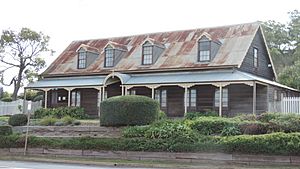
By the late 1840s, more people were settling in the area. The nearby town of Drayton grew, with its own newspaper, shops, and the Royal Bull's Head Inn, which still stands today. The first British people started living at "The Swamp" (Toowoomba) in 1849.
In 1852, Thomas Alford opened the first store in Toowoomba. The land for Toowoomba was first mapped out in 1849 and again in 1853. By 1858, Toowoomba was growing quickly. It had 700 people, three hotels, and many stores. Land that cost very little in 1850 was much more expensive by then. The locals wanted their own town, and a new municipality was officially created on November 24, 1860.
The first town council election was held on January 4, 1861, and William Henry Groom won. The railway from Ipswich opened in 1867, bringing more businesses. In 1892, Toowoomba and its surrounding areas were declared a township, and in 1904, Toowoomba became a city.
In July 1902, land from "The Lilley Estate" was sold. This estate was near Bridge, Mary, and Lindsay Streets, overlooking the Royal Agricultural Society's Showgrounds. In 1905, the Royal Agricultural Society and the Drayton and Toowoomba Agricultural and Horticultural Society joined together. The Toowoomba Showgrounds on Campbell Street became the only place for the yearly show.
The Rotary Club of Toowoomba started in 1930. During World War II, Toowoomba had an important fuel depot for aircraft, which was built in 1942. In 1985, the show moved from the Toowoomba Showgrounds to a new location in Glenvale.
Toowoomba was named Australia's Tidiest Town in 2008. On January 10, 2011, Toowoomba experienced a very bad flash flood. Heavy rain caused the city's creeks to overflow, damaging homes and roads. Two people sadly died in Toowoomba during this flood.
At the 2016 census, Toowoomba had 100,032 people. The median age was 38 years. About 19.1% of the population were children under 15, and 13.1% were 65 or older. Most residents (79.1%) were born in Australia. English was spoken at home by 84.6% of residents. Most homes (76.3%) were separate houses.
Toowoomba's Weather
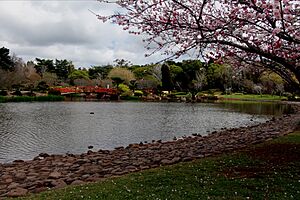
Toowoomba has a humid subtropical climate, meaning it has warm summers and cool winters. Because it's inland, high up on the Great Dividing Range, it often has strong winds, hail, fog, and cooler temperatures. Sometimes, it even gets a bit of snow! This is why Toowoomba is known for being cooler than many other Queensland cities. It's usually sunny, with over 100 clear days each year, mostly in winter.
In summer, the daily high temperatures average around 28°C, and in winter, they average around 17°C. Summer temperatures rarely go above 33°C, and winter days are seldom warmer than 23°C. Winter nights don't often drop below 0°C, but light frost can happen in the city center and more often in the western suburbs. The highest temperature ever recorded in Toowoomba was 40.8°C in February 2017, and the lowest was -4.4°C in July 1965.
The average yearly rainfall is about 735 mm, with most rain falling from November to March. January and February are the wettest months. Like other parts of southeast Queensland, Toowoomba can experience strong thunderstorms and sometimes even be affected by old tropical cyclones.
| Climate data for Toowoomba Airport (27º32'24"S, 151º54'36"E, 641 m AMSL) (1996–2024) | |||||||||||||
|---|---|---|---|---|---|---|---|---|---|---|---|---|---|
| Month | Jan | Feb | Mar | Apr | May | Jun | Jul | Aug | Sep | Oct | Nov | Dec | Year |
| Record high °C (°F) | 39.5 (103.1) |
40.8 (105.4) |
36.1 (97.0) |
30.6 (87.1) |
29.0 (84.2) |
27.9 (82.2) |
24.5 (76.1) |
32.0 (89.6) |
34.9 (94.8) |
36.4 (97.5) |
37.5 (99.5) |
38.3 (100.9) |
40.8 (105.4) |
| Mean daily maximum °C (°F) | 28.4 (83.1) |
27.7 (81.9) |
26.1 (79.0) |
23.2 (73.8) |
19.8 (67.6) |
17.0 (62.6) |
16.8 (62.2) |
18.8 (65.8) |
22.3 (72.1) |
24.6 (76.3) |
26.3 (79.3) |
27.7 (81.9) |
23.2 (73.8) |
| Mean daily minimum °C (°F) | 17.7 (63.9) |
17.6 (63.7) |
16.5 (61.7) |
13.4 (56.1) |
10.0 (50.0) |
7.5 (45.5) |
6.6 (43.9) |
7.6 (45.7) |
10.5 (50.9) |
12.9 (55.2) |
14.8 (58.6) |
16.7 (62.1) |
12.6 (54.8) |
| Record low °C (°F) | 12.6 (54.7) |
11.7 (53.1) |
9.3 (48.7) |
3.1 (37.6) |
−0.8 (30.6) |
−1.5 (29.3) |
−1.8 (28.8) |
−1.7 (28.9) |
1.9 (35.4) |
2.7 (36.9) |
5.6 (42.1) |
9.0 (48.2) |
−1.8 (28.8) |
| Average precipitation mm (inches) | 91.2 (3.59) |
106.3 (4.19) |
87.9 (3.46) |
30.1 (1.19) |
45.2 (1.78) |
34.2 (1.35) |
29.4 (1.16) |
28.8 (1.13) |
33.4 (1.31) |
67.0 (2.64) |
75.1 (2.96) |
103.6 (4.08) |
729.2 (28.71) |
| Average precipitation days (≥ 1.0 mm) | 7.2 | 7.6 | 7.8 | 4.2 | 4.6 | 4.6 | 4.0 | 3.7 | 4.2 | 6.5 | 6.5 | 7.6 | 68.5 |
| Average afternoon relative humidity (%) | 51 | 56 | 52 | 50 | 51 | 54 | 50 | 42 | 40 | 40 | 48 | 49 | 49 |
| Average dew point °C (°F) | 14.8 (58.6) |
15.6 (60.1) |
13.6 (56.5) |
10.4 (50.7) |
7.3 (45.1) |
5.9 (42.6) |
4.2 (39.6) |
3.2 (37.8) |
5.5 (41.9) |
7.3 (45.1) |
10.8 (51.4) |
13.4 (56.1) |
9.3 (48.8) |
| Source: Bureau of Meteorology | |||||||||||||
Buildings and History: Toowoomba's Architecture
Toowoomba's past is kept alive in its buildings. Examples of its rich history include Toowoomba City Hall, which was Queensland's first town hall built for that purpose. The National Trust's Royal Bull's Head Inn and many buildings on the heritage-listed Russell Street also show this history. East of the city center is the Caledonian Estate, an area with homes from the early 1900s, from small workers' cottages to grand houses, all in the classic wooden Queenslander style.
Toowoomba is also home to the Empire Theatre. It first opened in June 1911 as a silent movie house. A fire almost destroyed it in February 1933, but it was rebuilt and reopened in November 1933. The new Empire Theatre was designed in the art deco style, popular in the 1930s. After some years of not being looked after, the Empire Theatre was greatly renovated in the late 1990s. It still has much of its art deco style and decorations, especially the proscenium arch. The Empire Theatre can seat about 1,500 people and is now the largest regional theater in Australia.
The old Drayton railway station is now the DownSteam heritage railway and museum. It has old trains, including the only remaining C16 Class, No. 106 "Pride of Toowoomba," built in 1914.
The city also has the Cobb & Co Museum, which tells the story of the famous mail company that started by carrying mail and passengers to Brisbane. It also has Australia's largest collection of horse-drawn vehicles. The museum had a big renovation and reopened in September 2010.
Heritage-Listed Places
Toowoomba has many heritage-listed sites. Over fifty of them are on the Queensland Heritage Register, plus others on local lists.
How Toowoomba is Governed
Toowoomba is the main center for the Toowoomba Region local government area. The city is represented in the Parliament of Queensland by three elected members: one for Toowoomba North, one for Toowoomba South, and one for Condamine. In the national Commonwealth Parliament, Toowoomba is part of the Division of Groom, currently held by Garth Hamilton from the Liberal National Party of Queensland.
The current mayor of the Toowoomba Region is Geoff McDonald. He became mayor after Paul Antonio retired in July 2023.
Toowoomba's Economy
The Australian Defence Force is an important part of the local community. Many military personnel who work at the Oakey Army Aviation Centre (near Oakey, 29 km northwest of Toowoomba) and Borneo Barracks at Cabarlah live in Toowoomba. The main offices of Heritage Bank, Australia's largest mutual bank, along with FK Gardners, Wagners, McNab, Mort and Co Beef, and Namoi Cotton, are all in Toowoomba. The city itself serves as a central hub for a large economic area that stretches from Ipswich in the east to northern New South Wales in the south and the Queensland border in the west.
Learning in Toowoomba: Education
Toowoomba is a big education center, with many students from Western Queensland boarding at schools like Toowoomba Grammar, Fairholme College, Downlands College, and The Glennie School.
Primary Schools
|
State Schools:
|
Private/Religious Schools:
|
Secondary Schools
|
State Schools:
|
Private/Religious Schools:
|
Universities and Colleges
- University of Southern Queensland
- TAFE Queensland South West (formerly SQIT) has large campuses.
- University of Queensland has a small center in Toowoomba.
- Griffith University has a small health training facility in Toowoomba.
Toowoomba's Culture
Festivals and Events
Toowoomba is famous across Australia for its yearly Carnival of Flowers, held every September. Many of the city's parks and gardens are specially prepared for the carnival. There's also a home garden competition and a parade with flower floats. People come from all over the country, and a popular way to arrive from Brisbane is on special old steam and diesel trains, which brings back the feeling of travel from long ago. The "Food and Wine Festival," usually lasting three days, also happens during the Carnival of Flowers. It offers entertainment, food, and drinks and is a well-known part of the Carnival.
In 2009, the Carnival of Flowers was named one of the Q150 Icons of Queensland for its role as a major event and festival. The Toowoomba Carnival of Flowers won Gold Awards for Major Festival and Event at the Queensland Tourism Awards in 2015, 2016, and 2017, and at the Australian Tourism Awards in 2016 and 2017. In 2017, over 255,000 people attended the event.
Toowoomba also hosts the 'First Coat Art and Music Festival' every May. This street art festival has led to over 50 large public artworks throughout the city center. This has transformed previously unused laneways and helped reduce graffiti.
In March 2024, the first Toowoomba Fashion Festival was held. It featured three fashion shows with new and established designers. This festival aims to boost the fashion industry in regional Australia.
Local Food
Toowoomba was where the Weis Bar was created, famous for being the start of the Weis ice cream brand. However, in 2021, the company moved production, and the bar closed. Toowoomba is also known as the origin of Home Ice Cream, Homestyle Bake, and possibly even the Lamington. The city has a lively cafe and restaurant scene, often compared to Melbourne's for its quality and variety.
Sports in Toowoomba
Rugby League
Rugby league is a very popular sport in Toowoomba. A team from Toowoomba used to play in the Bulimba Cup. While Toowoomba doesn't have a team in the major national competitions now, it was home to the Toowoomba Clydesdales in the Queensland Cup state league. The Clydesdales were linked to the Brisbane Broncos in the National Rugby League (NRL) from 1999 to 2006. Toowoomba Sports Ground (Clive Berghofer Stadium) has hosted NRL trial matches since 2003, and premiership matches have been played there since 2018.
Association Football (Soccer)
Toowoomba has a semi-professional football (soccer) club, South West Queensland Thunder, which has many fans. Football Darling Downs is based in Toowoomba and manages football for the city and nearby towns. Toowoomba has 12 football clubs, including South West Queensland Thunder, Rockville Rovers, and Willowburn. A-League Men pre-season matches have been held at Toowoomba Sports Ground since 2006.
Aussie Rules Football
Australian rules football is played by four senior teams in the AFL Darling Downs competition: Coolaroo, Toowoomba Tigers, University of Southern Queensland, and South Toowoomba. The sport is growing in popularity among younger players, with eleven junior clubs in the region. In 2006, Brad Howard became the first player from Toowoomba to be drafted into the Australian Football League (AFL).
Other Sports
Toowoomba has clubs for many other sports, including cricket, archery, swimming, tennis, softball, baseball, netball, hockey, gridiron, and basketball. The city is home to the Toowoomba Mountaineers basketball team, which plays in the Queensland Basketball League (QBL).
Toowoomba has two golf courses: Toowoomba Golf Club Middle Ridge and City Golf Club Toowoomba. These clubs, along with others in the area, have an annual Pennant season where teams compete. City Golf Club also hosted the Queensland PGA Championship for several years.
Toowoomba is home to Clifford Park Racecourse, a horse racing track. The Toowoomba Turf Club was formed in 1882. In 1992, the club made Australian racing history by holding the first race ever run under electric lights. In 1996, they held the first night race meeting in Australia.
Toowoomba has several rugby union teams, including University of Southern Queensland Rugby Union Club and Toowoomba Rangers Rugby Union Club. These teams compete in the Darling Downs Rugby Union competition.
Cycling is also popular in Toowoomba. The Tour of Toowoomba became part of the Subaru National Road Series in 2010, attracting 15 teams. The Toowoomba Auto Club, founded in 1950, used to run races at nearby airfields and even on the streets of Middle Ridge in the late 1950s and early 1960s. The club built the Echo Valley facility, which started as a hillclimbing venue and is now a motocross track.
Toowoomba is home to four parkrun events: Toowoomba (started 2013), Highfields (started 2015), South Toowoomba (started 2018), and Picnic Point (started 2023). These parkrun events are very popular, with up to 500 participants.
Community Groups
The Toowoomba branch of the Queensland Country Women's Association meets at 263 Margaret Street. The Toowoomba City Business Women's branch meets at 161 Margaret Street.
There are six Rotary Clubs in Toowoomba. They are all active in the community and raise over $200,000 each year for various causes. The Rotary Club of Toowoomba meets at the Burke and Wills Hotel, 554 Ruthven Street.
Media in Toowoomba
Print Media
- The Darling Downs Gazette (published from 1858 to 1922)
- The Chronicle (published since 1861)
- High Country Herald
- The Coffee Gazette (published since 2014)
- Toowoomba's Mail (published since 2003)
Television
Toowoomba receives television services from three commercial national networks and two national non-commercial networks. These include Seven Queensland, SCA 10 (Network 10), WIN Television (Nine Network), ABC Television, and Special Broadcasting Service. All these services are broadcast in digital format.
- Seven Queensland (STQ), 7two, 7mate, 7Bravo, 7flix: These are channels owned and operated by the Seven Network.
- WIN Television, 9Gem, 9Go!, 9Life: These channels are linked to the Nine Network.
- SCA 10, 10 Bold, 10 Peach, Nickelodeon, Sky News Regional: These channels are linked to Network 10.
- Special Broadcasting Service, SBS, SBS Viceland, SBS Food, SBS World Movies, SBS WorldWatch and NITV
- Australian Broadcasting Corporation, ABC TV, ABC TV Plus, ABC Kids, ABC Me, ABC News
Seven Queensland and WIN Television both air 30-minute local news programs at 6pm on weekdays. These are put together in Toowoomba but broadcast from studios in Maroochydore and Wollongong.
Radio
Toowoomba has many different radio stations on both FM and AM frequencies. Some of these include:
- Hit 100.7 Darling Downs (100.7 FM)
- Triple M Darling Downs 864 (864 AM)
- ABC Southern Queensland (747 AM)
- 92.9 Voice FM (92.9 FM)
- River949 (94.9 FM)
- ABC News Radio (96.7 FM)
- Triple J (103.3 FM / 104.1 FM)
- ABC Local Radio Queensland (104.9 FM)
- ABC Classic FM (107.3 FM)
- 4WK (963 AM)
- 4AK (1242 AM)
- The Breeze (1620 AM)
Getting Around: Transport in Toowoomba
A local bus service, run by Bus Queensland Toowoomba, operates throughout the city. This is part of the Translink network. Stonestreets Coaches also run many school bus services in the city.
There are frequent bus services between Toowoomba and Brisbane, as well as other centers, operated by Greyhound Australia and Murrays.
Toowoomba station has a train service that runs twice a week from Brisbane to Charleville on Queensland Rail's The Westlander. Toowoomba is a hub for several railway lines used for both freight and passenger services. You can find old, unused railway stations in the suburbs (like Drayton and Harristown), which date back to when these areas were separate towns.
Toowoomba is served by Toowoomba Wellcamp Airport. This airport has flights from QantasLink and Rex Airlines to places like Brisbane, Sydney, Melbourne, Townsville, Whitsundays, and other destinations west of the city. The city's older main airport, Toowoomba City Aerodrome, is in the suburb of Wilsonton. This airport is now mainly used by the Royal Flying Doctor Service, LifeFlight, and the Darling Downs Aero Club.
City Services: Toowoomba's Infrastructure
Water Supply
Toowoomba's third water storage, Cressbrook Dam, was finished in 1983 and started supplying water in 1988. It can hold about 80,000 million liters, bringing the total capacity of the three dams (Cooby, Perseverance, and Cressbrook) to 126,000 million liters. The city also gets water from underground sources. Toowoomba sits above the eastern edge of the Great Artesian Basin, which is a huge underground water source.
From 1998 to 2005, rainfall was much lower than average, which led to a long drought. By mid-2005, the city's water supply was very low, below 30%. In March 2006, the dams fell below 25% capacity, and in December 2009, they reached an all-time low of 7.7%.
In 2006, the Toowoomba City Council asked residents to vote on a plan to use purified recycled water for drinking. The proposal was to filter water from the Wetalla Sewage Treatment Plant and return it to Cooby Dam. However, 62% of voters said no to this idea. After this, the city focused on other ways to save water, like collecting stormwater for public parks and adding filtered underground water to the supply. The city was under strict water restrictions.

In 2007, the Toowoomba City Council started drilling bores (deep wells) to get more water. They found good drinking water from some of these bores. Since September 2009, the Toowoomba Regional Council has been adding water from the Great Artesian Basin to the city's supply. Underground water now provides one-third of the city's total water needs.
The state government built a $187 million pipeline from Wivenhoe Dam to Toowoomba. Water started being pumped along this 38-kilometer pipeline to Cressbrook Dam in January 2010.
Famous People from Toowoomba
Many notable people have come from Toowoomba. You can find a full list of them in the main article about people from Toowoomba.
Sister Cities
Toowoomba has special "sister city" relationships with three international cities. These connections help promote cultural exchange and friendship.
Religion in Toowoomba
In 2021, the 2021 census showed that 32.5% of people in Toowoomba reported having no religion. For those with religious affiliations, 20.2% were Catholic, 14.2% were Anglican, and 5.1% belonged to other Christian groups.
The Toowoomba Wesleyan Methodist Church is located at 267 North Street, Wilsonton Heights. It is part of the Wesleyan Methodist Church of Australia. The Toowoomba Chinese Wesleyan Methodist Church is at 21 Kookaburra Court, Glenvale, and is also part of the Wesleyan Methodist Church of Australia.
|
See also
 In Spanish: Toowoomba para niños
In Spanish: Toowoomba para niños


